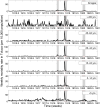Mortality patterns associated with the 1918 influenza pandemic in Mexico: evidence for a spring herald wave and lack of preexisting immunity in older populations
- PMID: 20594109
- PMCID: PMC2945372
- DOI: 10.1086/654897
Mortality patterns associated with the 1918 influenza pandemic in Mexico: evidence for a spring herald wave and lack of preexisting immunity in older populations
Abstract
Background: Although the mortality burden of the devastating 1918 influenza pandemic has been carefully quantified in the United States, Japan, and European countries, little is known about the pandemic experience elsewhere. Here, we compiled extensive archival records to quantify the pandemic mortality patterns in 2 Mexican cities, Mexico City and Toluca.
Methods: We applied seasonal excess mortality models to age-specific respiratory mortality rates for 1915-1920 and quantified the reproduction number from daily data.
Results: We identified 3 pandemic waves in Mexico City in spring 1918, autumn 1918, and winter 1920, which were characterized by unusual excess mortality among people 25-44 years old. Toluca experienced 2-fold higher excess mortality rates than Mexico City but did not experience a substantial third wave. All age groups, including that of people 65 years old, experienced excess mortality during 1918-1920. Reproduction number estimates were <2.5, assuming a 3-d generation interval.
Conclusion: Mexico experienced a herald pandemic wave with elevated young adult mortality in spring 1918, similar to the United States and Europe. In contrast to the United States and Europe, there was no mortality sparing among Mexican seniors 65 years old, highlighting potential geographical differences in preexisting immunity to the 1918 virus. We discuss the relevance of our findings to the 2009 pandemic mortality patterns.
Conflict of interest statement
The authors have declared that no competing interests exist.
Figures



References
-
- Johnson NP, Mueller J. Updating the accounts: global mortality of the 1918–1920 “Spanish” influenza pandemic. Bull Hist Med. 2002;76:105–15. - PubMed
-
- Ammon CE. Spanish flu epidemic in 1918 in Geneva, Switzerland. Euro Surveill. 2002;7:190–2. - PubMed
-
- Murray CJ, Lopez AD, Chin B, Feehan D, Hill KH. Estimation of potential global pandemic influenza mortality on the basis of vital registry data from the 1918–20 pandemic: a quantitative analysis. Lancet. 2006;368:2211–8. - PubMed
Publication types
MeSH terms
Grants and funding
LinkOut - more resources
Full Text Sources
Medical

